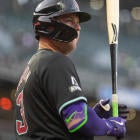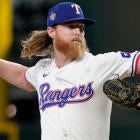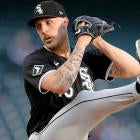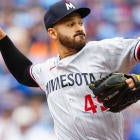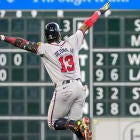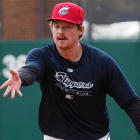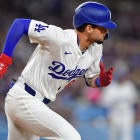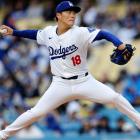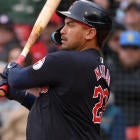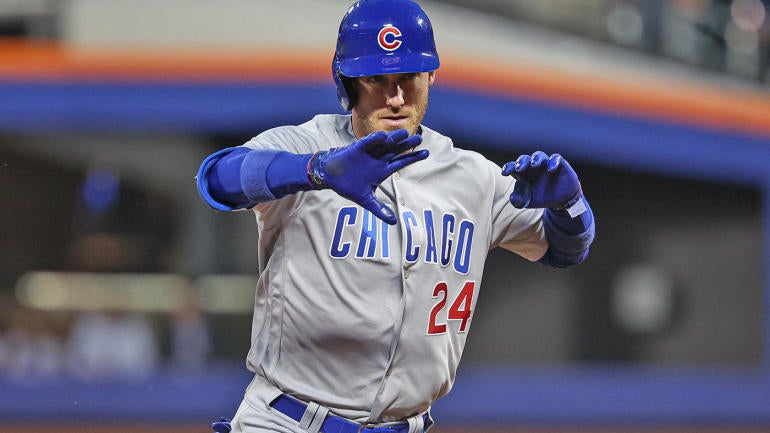
One of the last and biggest dominoes left in free agency fell Sunday, with Cody Bellinger agreeing to return to the Cubs on a three-year contract that could see him become a free agent in as little as a year. And the structure of the contract suggests the market was just as confused about how to value Bellinger as the Fantasy Baseball community has been this offseaosn.
Bellinger, who enjoyed a bounceback season in 2023 after signing with the Cubs, agreed to a deal that would pay him $80 million over three years, but with opt-outs after each of the first two seasons. It's a deal with plenty of upside for Bellinger, who could become a free agent for the third offseason in a row as a 29-year-old if he has another good season. He hit .307/.356/.525 with 26 homers and 20 steals in 130 games for the Cubs last season, finishing as a top-20 player in Fantasy, and with his defense and baserunning still bringing plenty of value to the Cubs, it's a deal that definitely makes sense for them, too.
But there's certainly downside here; Bellinger hit .193/.256/.355 in his prior two seasons, playing so poorly that the Dodgers non-tendered him last offseason. Regression back to that level would almost certainly lead Bellinger to opt-in for 2025 and 2026, and could leave the Cubs stuck with a pretty big liability in their lineup. Bellinger certainly didn't get the long-term deal he was hoping for this offseason, but he did lock in some security with this deal after the market ended up significantly cooler on him than expected.
And I think the fact that the market didn't seem to buy Bellinger's 2023 bounceback says something about how we should be viewing him for Fantasy. On the whole, the people running MLB teams are a lot smarter than your average Fantasy Baseball analyst; certainly, they have access to better proprietary data than we do. And, while Bellinger looked the part of a player you give a $200-million contract as a 28-year-old free agent in 2023 on the surface, the underlying numbers suggest we should be a lot more skeptical about him in 2024, and that's exactly how the market treated him.
Because, while Bellinger hit .307, his expected batting average was just .268. He cut his strikeout rate significantly, to 15.6%, the best mark of his career. However, his quality of contact remained very poor. In fact, according to BaseballSavant's expected wOBA on contact metric, Bellinger was only slightly better in 2023 than he was in 2021 or 2022, with a .357 mark compared to .348 and .344 the previous two seasons.
Now, with the improved strikeout rate, Bellinger was still a significantly better hitter in 2023 than the prior two seasons, even if his quality of contact wasn't; his .327 expected wOBA was by far his best mark since 2020. However, that was still well short of the actual .370 mark he produced. He had better results on balls in play than expected and hit a few more homers than expected based solely on his quality of contact, which was, to be kind, very poor.
In 2019, when Bellinger won the MVP, he averaged 91.1 mph on his batted balls, and it was still above 89 mph each of the next three seasons; last season, it dipped all the way to 87.9 mph. He also sported his lowest hard-hit% (share of batted balls over 95 mph), and his lowest barrel rate (6.1%), so no matter which metric you used, Bellinger hit the ball with less authority, less consistently than he ever had.
Now, that's not everything, of course. Some players routinely overperform their expected metrics, like Marcus Semien and Jose Altuve, thanks to plus athleticism, bat control, and a fly-ball and pull-heavy approach, for a very simple reason: A 360-foot fly ball hit to center field is an out, but a 360-foot fly ball down the line is a home run. Bellinger is a good athlete, and he does hit a lot of fly balls and he does hit the ball to the pull side quite a bit, so it's not unreasonable to expect him to outrun his expected metrics by a bit. Probably not by a 40-plus point gap in wOBA, but still. The problem there is, 2023 was the first time he had ever really outperformed his underlying metrics, despite always having those skills.
Which is all to say, I'm not sure expecting Bellinger to repeat 2023 makes a ton of sense. The good news is, you don't have to draft him for that – he was a top-20 player in Roto in 2023, and his ADP is sitting around 60th at various sites. There's room for regression and for profit here. But, the fact that the market in free agency was so tepid on Bellinger, despite the fact that even if the bat regressed, he'll still bring plenty of value with his glove and legs, says something about how much skepticism there is about what he managed last season.
The good news is, we've seen him succeed in Chicago, with the friendly confines of Wrigley Field potentially playing a part in his overperformance in 2023. He'll be returning there, so whatever benefit he got from that, plus a pretty solid Cubs lineup around him, should still be there. If he was going to repeat 2023, his best chances would likely have been in Chicago, so he's got that going for him.
Bellinger's return does have some ramifications for a couple of young Cubs chances of getting everyday playing time. Bellinger will likely play center field for the Cubs on Opening Day after the acquisition of Michael Busch this offseason, but that's not necessarily guaranteed if Pete Crow-Armstrong has a good spring. He's arguably the best defensive outfielder in the minors right now, and has produced in the upper minors, so if he shows he's ready, that could push Bellinger to first base. Which would likely push Busch to the DH spot. That would lessen his margin for error considerably, so Busch couldn't afford to struggle like he did last season in the majors; he hit just .167/.247/.292 for the Dodgers in 2023, but was a .323/.431/.618 hitter in Triple-A.
Both Busch and Crow-Armstrong have some sleeper appeal for Fantasy, but Bellinger's return makes their path a little more treacherous. But both are basically free at the end of drafts, so there's little risk there. We'll just have to see how spring training shakes out to see their chances of having the jobs we want for them in 2024.














